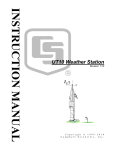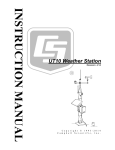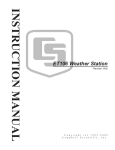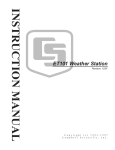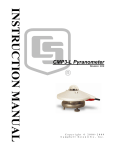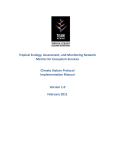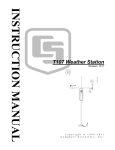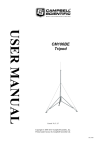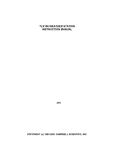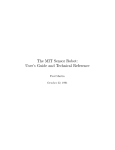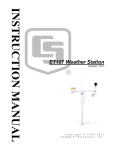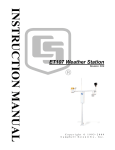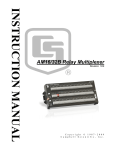Download Campbell CM10 Installation manual
Transcript
CM6/CM10 Tripod Weather Station Installation Manual Revision: 7/10 C o p y r i g h t © 1 9 9 3 - 2 0 1 0 C a m p b e l l S c i e n t i f i c , I n c . Warranty and Assistance The CM6 AND CM10 TRIPODS are warranted by Campbell Scientific, Inc. to be free from defects in materials and workmanship under normal use and service for twelve (12) months from date of shipment unless specified otherwise. Batteries have no warranty. Campbell Scientific, Inc.'s obligation under this warranty is limited to repairing or replacing (at Campbell Scientific, Inc.'s option) defective products. The customer shall assume all costs of removing, reinstalling, and shipping defective products to Campbell Scientific, Inc. Campbell Scientific, Inc. will return such products by surface carrier prepaid. This warranty shall not apply to any Campbell Scientific, Inc. products which have been subjected to modification, misuse, neglect, accidents of nature, or shipping damage. This warranty is in lieu of all other warranties, expressed or implied, including warranties of merchantability or fitness for a particular purpose. Campbell Scientific, Inc. is not liable for special, indirect, incidental, or consequential damages. Products may not be returned without prior authorization. The following contact information is for US and International customers residing in countries served by Campbell Scientific, Inc. directly. Affiliate companies handle repairs for customers within their territories. Please visit www.campbellsci.com to determine which Campbell Scientific company serves your country. To obtain a Returned Materials Authorization (RMA), contact Campbell Scientific, Inc., phone (435) 753-2342. After an applications engineer determines the nature of the problem, an RMA number will be issued. Please write this number clearly on the outside of the shipping container. Campbell Scientific's shipping address is: CAMPBELL SCIENTIFIC, INC. RMA#_____ 815 West 1800 North Logan, Utah 84321-1784 For all returns, the customer must fill out a “Declaration of Hazardous Material and Decontamination” form and comply with the requirements specified in it. The form is available from our website at www.campbellsci.com/repair. A completed form must be either emailed to [email protected] or faxed to 435-750-9579. Campbell Scientific will not process any returns until we receive this form. If the form is not received within three days of product receipt or is incomplete, the product will be returned to the customer at the customer’s expense. Campbell Scientific reserves the right to refuse service on products that were exposed to contaminants that may cause health or safety concerns for our employees. CM6/CM10 Table of Contents PDF viewers note: These page numbers refer to the printed version of this document. Use the Adobe Acrobat® bookmarks tab for links to specific sections. 1. Preparation and Siting .............................................1-1 1.1 Installation Tasks .................................................................................. 1-1 1.1.1 Indoors ........................................................................................ 1-1 1.1.2 Outdoors...................................................................................... 1-1 1.2 Tools Required ..................................................................................... 1-2 1.2.1 Tools for Tripod Installation....................................................... 1-2 1.2.2 Tools For Instrumentation and Maintenance .............................. 1-2 1.2.3 Supplies for Power and Communications Options ..................... 1-3 1.3 Siting and Exposure.............................................................................. 1-3 1.3.1 Wind Speed and Direction .......................................................... 1-3 1.3.2 Temperature and Relative Humidity........................................... 1-3 1.3.3 Precipitation ................................................................................ 1-4 1.3.4 Solar Radiation............................................................................ 1-4 1.3.5 Soil Temperature......................................................................... 1-4 2. CM6/CM10 Tripod Installation .................................2-2 2.1 2.2 2.3 2.4 2.5 2.6 Specifications........................................................................................ 2-2 Tripod Parts .......................................................................................... 2-3 Tripod Installation ................................................................................ 2-3 Tripod Grounding ................................................................................. 2-5 CM10 Guy Kit Installation ................................................................... 2-7 Sensor Mounting Brackets.................................................................. 2-10 2.6.1 Crossarm Mounting .................................................................. 2-10 2.6.1.1 CM202, CM204, CM206 Crossarms .............................. 2-10 2.6.1.2 019ALU Crossarm Sensor Mount................................... 2-10 2.6.2 Gill Radiation Shields (41303-5A, 41003-5, 41005-5) ............ 2-11 2.6.3 CM225 Pyranometer Stand....................................................... 2-11 3. Instrumentation Installation.....................................3-1 3.1 Enclosure, Datalogger, Power Supply .................................................. 3-1 3.1.1 Enclosure .................................................................................... 3-1 3.1.2 Datalogger and Power Supply .................................................... 3-3 3.1.3 BPALK Alkaline Power Supply ................................................. 3-3 3.1.4 PS100 Rechargeable Power Supply............................................ 3-4 3.1.5 Solar Panel .................................................................................. 3-4 3.2 Sensor Connection................................................................................ 3-6 3.3 Communication and Data Storage Peripherals ..................................... 3-7 3.3.1 CFM100, NL115, or NL120 ....................................................... 3-7 3.3.2 COM220 Phone Modems ........................................................... 3-7 3.3.3 Cellular Transceivers .................................................................. 3-8 3.3.4 SRM-5A Rad Modem and SC932A Interface ............................ 3-9 3.3.4.1 SRM-5A at the Datalogger................................................ 3-9 3.3.4.2 SRM-5A at the Computer.................................................. 3-9 i CM6/CM10 Table of Contents 3.3.5 RF500M RF Modem and RF310-Series Transceivers .............. 3-12 3.3.5.1 RF500M Modem Configuration ...................................... 3-12 3.3.5.2 RF500M RF Base Station................................................ 3-13 3.3.5.3 Install Nearest Repeater/Field Station ............................. 3-14 3.3.6 MD485 Multidrop Interface ...................................................... 3-14 3.3.6.1 MD485 Multidrop Interface at the Datalogger ................ 3-14 3.3.6.2 MD485 Multidrop Interface at the Computer.................. 3-15 3.4 Sealing and Desiccating the Enclosure ............................................... 3-15 4. Sensor Installation................................................... 4-1 4.1 034B Met One Windset ........................................................................ 4-1 4.2 05103, 05103-45, 05106, and 05305 RM Young Wind Monitors........ 4-2 4.3 03002 RM Young Wind Sentry Wind Set ............................................ 4-3 4.3.1 03002 Mounted to the Mast ........................................................ 4-3 4.3.2 03002 Mounted to CM202, CM204, or CM206 Crossarm ......... 4-3 4.4 Licor Silicon Radiation Sensors (LI200X, LI200S, LI190SB)............. 4-4 4.5 107/108 Temperature Probe.................................................................. 4-4 4.6 107/108 Soil Temperature Probe .......................................................... 4-6 4.7 HMP50 Vaisala Temperature and RH Probe ........................................ 4-6 4.8 HMP45C/HMP35C Vaisala Temperature and RH Probe ..................... 4-8 4.9 CS100 or CS106 Barometric Pressure Sensor ...................................... 4-9 4.10 Texas Electronics Tipping Bucket Rain Gages (TE525, TE525WS, TE525MM).................................................................... 4-9 4.11 TB4, TB4MM or CS700 Rain Gage ................................................. 4-10 4.12 SR50A Sonic Ranging Sensor .......................................................... 4-11 4.12.1 Beam Angle............................................................................. 4-11 4.12.2 Mounting Height ..................................................................... 4-11 4.12.2.1 Reference Point ............................................................. 4-12 4.12.3 Mounting Options ................................................................... 4-12 4.13 CS616 Water Content Reflectometer................................................ 4-14 4.14 237 Leaf Wetness Sensor.................................................................. 4-15 4.15 257 Soil Moisture Sensor.................................................................. 4-16 4.16 CS210 Enclosure Humidity Sensor................................................... 4-17 4.17 Wind Direction Sensor Orientation................................................... 4-17 4.17.1 Determining True North and Sensor Orientation .................... 4-17 4.17.2 National Geophysical Data Center Web Site .......................... 4-18 5. Standard Software Installation ............................... 5-1 5.1 Datalogger Program .............................................................................. 5-1 5.2 Weather Station or Datalogger Support Suite....................................... 5-1 5.3 Quick Start Review ............................................................................... 5-1 6. Maintenance and Troubleshooting......................... 6-1 6.1 Maintenance.......................................................................................... 6-1 6.1.1 Instrumentation Maintenance ...................................................... 6-1 6.1.2 Batteries....................................................................................... 6-1 6.1.3 Desiccant ..................................................................................... 6-2 6.1.4 Sensor Maintenance .................................................................... 6-2 ii CM6/CM10Table of Contents 6.2 TroubleShooting ................................................................................... 6-3 6.2.1 No Response Using the Keypad ................................................. 6-3 6.2.2 No Response from Datalogger through SC32B or Modem Peripheral ................................................................................ 6-3 6.2.3 NaN Displayed in a Variable ...................................................... 6-4 6.2.4 Unreasonable Results Displayed in a Variable ........................... 6-4 Figures 1.3-1. Effect of Structure on Wind Flow .................................................... 1-5 2-1. CM10 Weather Station........................................................................ 2-1 2-2. Extending the Tripod Legs .................................................................. 2-4 2-3. Tripod and Component Orientation .................................................... 2-5 2-4. Ground Rod and Clamp....................................................................... 2-6 2-5. Tripod Ground Connections................................................................ 2-7 2-6. Guy Wire Installation ........................................................................... 2-8 2-7. Thimble Twisting ................................................................................ 2-8 2-8. Turnbuckle Assembly.......................................................................... 2-9 2-9. CM210 crossarm-to-pole bracket (top) is included with the crossarm for attaching the crossarm to the tripod’s mast. .......... 2-10 2-10. 019ALU Crossarm and Lightning Rod ........................................... 2-11 2-11. CM225 Solar Radiation Mount with a LI2003S Leveling Base and LI200X Solar Radiation Sensor........................................... 2-12 2-12. CM225 Attached to a Mast ............................................................. 2-12 3.1-1. An enclosure with the “-MM” mounting option attaches to a tripod mast via u-bolts .................................................................. 3-2 3.1-2. This exploded view shows the components of a “-MM” bracket..... 3-2 3.1-3. An enclosure attached to a tripod mast............................................. 3-3 3.1-4. CR1000 and PS100 Mounted to an Enclosure Backplate ................ 3-5 3.1-5. SP10 Solar Panel .............................................................................. 3-5 3.2-1. Routing and Wiring Sensor Leads to the Datalogger....................... 3-6 3.3-1. The NL115 connects to the CR1000’s peripheral port allowing data to be stored on removable Compact Flash cards................... 3-7 3.3-2. COM220 Modem with Surge Protector ........................................... 3-8 3.3-3. SRM-5A Rad Modem and SC932A Interface................................ 3-10 3.3-4. SRM-5A Wiring............................................................................. 3-11 3.3-5. You can configure any two types of interface ports (RS-485, RS-232, and CS I/O) to be used at a time................................... 3-15 3.4-1. Enclosure Supply Kit ..................................................................... 3-16 4.1-1. Met One 034B Wind Speed and Direction Sensor........................... 4-1 4.2-1. 05103 RM Young Wind Monitor..................................................... 4-2 4.3-1. 03002 Mounted to a CM200-series Crossarm.................................. 4-3 4.4-1. LI200X/LI200S/LI190SB and LI2003S Leveling Fixture ............... 4-4 4.5-1. 107 Temperature Probe .................................................................... 4-5 4.7-1. HMP50 Temperature and RH Probe ................................................ 4-7 4.8-1. HMP45C Vaisala Temperature and RH Probe................................. 4-8 4.10-1. TE525 Texas Electronics Rain Gage.............................................. 4-9 4.11-1. TB4 or TB4MM Mounted onto a CM310 Pole via the CM240 Mount ......................................................................................... 4-10 4.12-1. Beam Angle Clearance ................................................................. 4-11 4.12-2. Distance from Edge of Transducer Housing to Grill.................... 4-12 4.12-3. SR50A Mounted to a Crossarm via the 19517 Mounting Kit ...... 4-13 4.12-4. The SR50A Mounted to the Crossarm Shown from Another Angle .......................................................................................... 4-13 4.12-5. SR50A - Mounted using Nurail and C2151 Mounting Stem ....... 4-14 iii CM6/CM10 Table of Contents 4.13-1. CS616 Water Content Reflectometer with #14383 Probe Insertion Guide ........................................................................... 4-15 4.14-1. 237 Leaf Wetness Sensor ............................................................. 4-15 4.15-1. 257 Soil Moisture Sensor ............................................................. 4-16 4.16-1. CS210 Installed on a CR1000 ...................................................... 4-17 4.17-1. Magnetic Declination for the Contiguous United States .............. 4-18 4.17-2. Declination Angles East of True North are Subtracted from 0 to get True North ........................................................................ 4-19 4.17-3. Declination Angles West of True North are Added to 0 to get True North ........................................................................ 4-19 Tables 2-1. CM6 Heights and Leg Diameters ........................................................ 2-2 2-2. CM10 Heights and Leg Diameters ...................................................... 2-2 2-3. CM10 Guy Kit Parts ............................................................................ 2-7 iv Section 1. Preparation and Siting 1.1 Installation Tasks 1.1.1 Indoors • Immediately upon receipt of your shipment… ⇒ Open shipping cartons. ⇒ Check contents against invoice. Contact CSI immediately about any shortages. • Several days prior to the planned installation date… ⇒ Collect tools and site information (Section 1) ⇒ Assemble datalogger, communications device, and power supply in enclosure (Section 3) ⇒ Install datalogger support software on PC (Section 5) ⇒ Establish communications between the datalogger and the PC (Section 5) ⇒ Program datalogger, test sensors, and retrieve data (Section 5) ⇒ Trial run the tripod installation, assembling as much as possible (Section 2) ⇒ Repackage equipment for transport to the field site 1.1.2 Outdoors • Locate suitable site (Section 1) • Prepare tower or tripod base (Section 2) • Raise tripod (Section 2) • Install instrumentation enclosure (Section 3) • Install sensors (Section 4) 1-1 Section 1. Preparation and Siting 1.2 Tools Required Tools required to install and maintain a weather station are listed below. 1.2.1 Tools for Tripod Installation Shovel Rake Open end wrenches: 3/8", 7/16", ½", (2) 9/16" Magnetic compass 6' Step ladder Tape measure (12') Level (12" to 24") Small sledge hammer Teflon tape or pipe dope Allen hex wrench (5/64) 1.2.2 Tools For Instrumentation and Maintenance Lock and key for enclosure Magnetic declination angle (Section 4.19) Magnetic compass Straight bit screwdrivers (small, medium, large) Phillips-head screwdrivers (small, medium) Small diagonal side-cuts Needle-nose pliers Wire strippers Pocket knife Calculator Volt / Ohm Meter Electrical Tape Step ladder (6') Station manuals Station log and pen Open end wrenches: 3/8", 7/16", ½", (2) 9/16" Socket wrench and 7/16" deep well socket Adjustable wrench Pliers Conduit and associated tools (as required) Felt-tipped marking pen Claw hammer Pipe wrench (12") Tape measure (12') Level (12" to 24") Teflon tape or pipe dope 1-2 Section 1. Preparation and Siting 1.2.3 Supplies for Power and Communications Options AC Power Wire, conduit, and junction boxes as needed Phone Modem Hayes compatible calling modem for PC Phone line to weather station or junction box Short-Haul Modem 4 Conductor communications cable from PC to weather station or junction box 6' copper ground rod and clamp for PC surge protection (optional) 1.3 Siting and Exposure CAUTION If any part of the weather station comes in contact with power lines, you could be killed. Contact local utilities for the location of buried utility lines before digging or driving ground rods. Selecting an appropriate site for the weather station is critical in order to obtain accurate meteorological data. In general, the site should be representative of the general area of interest, and away from the influence of obstructions such as buildings and trees. The weather station should not be located where sprinkler irrigation water will strike sensors or instrument enclosure. Some general guidelines for site selection are listed below, which were condensed from EPA (1988)1, WMO (1983)2, and AASC (1985)3 publications. 1.3.1 Wind Speed and Direction Wind sensors should be located over open level terrain, and at a distance of at least ten times (EPA) the height of any nearby building, tree or other obstruction, as illustrated in Figure 1.3-1. Standard measurement heights: 3.0 m ± 0.1 m recommended (AASC) 2.0 m ± 0.1 m, 10.0 m ± 0.5 m optional (AASC) 10.0 m (WMO and EPA) 1.3.2 Temperature and Relative Humidity Sensors should be located over an open level area at least 9 m (EPA) in diameter. The surface should be covered by short grass, or where grass does not grow, the natural earth surface. Sensors should be located at a distance of at least four times the height of any nearby obstruction and at least 30 m (EPA) from large paved areas. Sensors should be protected from thermal radiation, and adequately ventilated. 1-3 Section 1. Preparation and Siting Situations to avoid include: • • • • • • • • • large industrial heat sources rooftops steep slopes sheltered hollows high vegetation shaded areas swamps areas where snow drifts occur low places holding standing water after rains Standard measurement heights: 1.5 m ± 1.0 m (AASC) 1.25 - 2.0 m (WMO) 2.0 m temperature (EPA) 2.0 m and 10.0 m for temperature difference (EPA) 1.3.3 Precipitation A rain gage should be sited on level ground that is covered with short grass or gravel. In open areas, the distance to obstructions should be two to four times (EPA, AASC) the height of the obstruction. The height of the opening should be as low as possible, but should be high enough to avoid splashing from the ground. Wind shields, such as those used by the National Weather Service, are recommended for open areas. Collectors should be heated, if necessary, to properly measure frozen precipitation. The gage must be mounted above the average level of snow accumulation in areas that experience significant snowfall. Standard measurement heights: 1.0 m ± 1.0 cm (AASC) 30.0 cm minimum (WMO, EPA) 1.3.4 Solar Radiation Pyranometers should be located to avoid shadows on the sensor at any time. Mounting it on the southern most (northern hemisphere) portion of the weather station will minimize the chance of shading from other weather station structures. Reflective surfaces and sources of artificial radiation should be avoided. The height at which the sensor is mounted is not critical. 1.3.5 Soil Temperature The measurement site for soil temperature should be at least 1 m2 and typical of the surface of interest. The ground surface should be level with respect to the immediate area (10 m radius). 1-4 Section 1. Preparation and Siting Standard measurement depths: 10.0 cm ± 1.0 cm (AASC) cm, 10.0 cm, 50.0 cm, 100.0 cm (WMO) FIGURE 1.3-1. Effect of Structure on Wind Flow References 1 EPA, (1987). On-Site Meteorological Program Guidance for Regulatory Modeling Applications, EPA-450/4-87-013. Office of Air Quality Planning and Standards, Research Triangle Park, North Carolina 27711. 2 WMO, (1983). Guide to Meteorological Instruments and Methods of Observation. World Meteorological Organization No. 8, 5th edition, Geneva, Switzerland. 3 The State Climatologist, (1985) Publication of the American Association of State Climatologists: Height and Exposure Standards for Sensors on Automated Weather Stations, v. 9, No. 4 October, 1985. 4 EPA, (1989). Quality Assurance Handbook for Air Pollution Measurement Systems, EPA Office of Research and Development, Research Triangle Park, North Carolina 27711. 1-5 Section 1. Preparation and Siting 1-6 Section 2. CM6/CM10 Tripod Installation The CM6 and CM10 tripods provide a support structure for mounting weather station components. Figure 2-1 shows a typical guyed CM10 tripod weather station equipped with instrumentation enclosure, meteorological sensors, and solar panel. FIGURE 2-1. CM10 Weather Station 2-1 Section 2. CM6/CM10 Tripod Installation 2.1 Specifications CM6 Tripod Maximum height (zero leg extension) Minimum height (full leg extension) Wind Load (Wind Sensors at 2 meters)* Maximum wind load Gust survival Tripod Leg Diameter (See Table 2-1) d = diameter h = height at top of bell reducer d = 2 (4.834 + (54.52 - (h - 42.4)2 ) 0.5) 7.5 ft (2.3 m) 5.5 ft (1.7 m) 100 mph 130 mph CM10 Tripod Maximum height (zero leg extension) 11 ft (3.4 m) Minimum height (full leg extension) 7.2 ft (2.2 m) Wind Load (Wind Sensors at 3 meters)* No Guy Wires Maximum 70 mph Gust survival 100 mph With Guy Wires Maximum 120 mph Gust survival 150 mph Tripod Leg Diameter (See Table 2-2) d = diameter h = height at top of bell reducer d = 2 (4.834 + (78.752 - (h - 62.35)2 )0.5) *Wind Load data assumes 4.5 ft2 of area placed at the top of the tripod mast TABLE 2-1. CM6 Heights and Leg Diameters Height mark is 1 1/4 inch above bell reducer Height (In) Diameter (In) 70 104 6/8 72 102 3/8 74 99 6/8 76 97 78 93 6/8 TABLE 2-2. CM10 Heights and Leg Diameters Height (In) 109 111 113 115 117 2-2 Diameter (In) 138 135 1/8 131 7/8 128 1/2 125 Section 2. CM6/CM10 Tripod Installation 2.2 Tripod Parts Tripods are either shipped complete and mostly assembled (CM6 or CM10), or as a kit that requires the user to supply some parts (CM10K). If a preassembled CM6 or CM10 Tripod was ordered, the following parts should have been received: (1) Tripod Base Assemble (1) Mast Assembly (1) Cross Arm Mount (Short Pipe) (1) Lightning Rod with Clamp (1) Grounding Rod with Clamp (1) 5 ft 4 AWG Wire (1) 4 ft 12 AWG Wire (3) Hold Down Stakes (12) Cable Ties If the CM10K Tripod Kit was received, first assemble the tripod base assembly and mast assembly according to Section 1 in the CM10K Tripod Kit Manual. The following items are also part of the CM10K Tripod Kit: (1) Cross Arm Mount (Short Pipe) (1) Lightning Rod with Clamp (1) Grounding Rod with Clamp The following items need to be procured to complete the CM10K Tripod Kit: (1) 5 ft 4 AWG Wire (1) 4 ft 12 AWG Wire (3) Hold Down Stakes (12) Cable Ties 2.3 Tripod Installation CM6 and CM10 tripods are designed to allow installation in many types of terrain. The following installation instructions, however, assume an installation on flat and reasonably level ground. 1. Prepare the area where the tripod will be installed. In most installations, the tripod requires an area 9 feet (CM6) or 12 feet (CM10) in diameter. Natural vegetation and the ground surface should be disturbed as little as possible, but brush and tall weeds should be removed. 2. Lay the tripod base and mast assemblies on the ground. Apply pipe dope or Teflon tape to threads on the crossarm mount (short pipe) and the 1 1/4 inch end of the mast. To prevent cross-threading, hand thread the crossarm mount into the mast’s bell reducer and then tighten with a pipe wrench. Hand thread the mast into the threaded coupling on the tripod center bracket and then tighten with a pipe wrench. 3. Using a tape measure and a felt-tipped pen, mark the tripod legs to indicate how far they should extend. From the end of the 3/4” pipe that 2-3 Section 2. CM6/CM10 Tripod Installation attaches to the foot (Figure 2-2), measure up 23” on the CM10, or 26” on the CM6, and mark each leg with a felt tip pen. 4. Each leg has a slide collar with a single bolt for loosening or tightening the collar (Figure 2-2). Loosen the bolt on each collar with a 1/2” wrench. FIGURE 2-2. Extending the Tripod Legs NOTE 5. Stand the tripod upright and orient it so one leg points south (Figure 2-3). Extend the leg until the top of the slide collar is even with the mark from Step 3 and tighten the bolt. Extend the other legs in the same manner. 6. Plumb the mast by adjusting the south and northeast facing legs. Loosen the slide-collar bolt on the south facing leg. With the level on the south side of the mast, adjust the leg so the level reads plumb, then tighten the bolt. Repeat the same procedure for the northeast facing leg with the level on the east side of the mast. Adjusting the legs can be made easier by spraying the slide collar and leg with a silicon spray, and tapping on the leg with a hammer. 7. 2-4 Three rebar stakes are provided for securing the tripod to the ground. Drive the stakes through the holes in the feet. Some users prefer to drive 4 foot “T” posts next to each leg, and attach the legs to the posts with 2” ubolts. Section 2. CM6/CM10 Tripod Installation CROSSARM SENSOR MOUNT PYRANOMETER MOUNTING ARM FIGURE 2-3. Tripod and Component Orientation 2.4 Tripod Grounding Ground the tripod and shown in Figures 2-1, 2-4, and 2-5. 1. Drive the ground rod close to the center of the tripod using a fence post driver or sledge hammer. Slide the clamp down the rod before driving it in the ground. This will eliminate the frustration of trying to get the clamp to fit over a hammer damaged rod end. Drive the rod at an angle if an impenetrable hardpan layer exists. In hard clay soils, a gallon jug of water can be used to “prime” the soil and hole to make driving the rod easier. 2. Loosen the bolt that attaches the clamp to the ground rod. Strip 1 inch of insulation from one end of the 4 AWG wire and insert it between the rod and the clamp. Tighten the clamp bolt (Figure 2-4). 2-5 Section 2. CM6/CM10 Tripod Installation 4 AWG Wire Clamp Ground Rod FIGURE 2-4. Ground Rod and Clamp 2-6 3. Loosen the set screws in the two brass ground lugs attached to the center bracket of the tripod (Figure 2-5). Strip 1 inch of insulation from the other end of the 4 AWG wire and insert it into the lower ground lug. Tighten the set screw. Strip 1 inch of insulation from one end of the 12 AWG wire and insert it into the upper ground lug. Tighten the set screw. The other end of the 12 AWG wire will attach to the ground lug of the instrumentation enclosure. 4. Attach the lightning rod to the mast as shown in Figure 2-1. If the weather station includes an 019ALU crossarm, attach it to the mast first. Loosen the two screws on the lightning rod mounting bracket. Position the mounting bracket 4 inches down from the top of the mast, then tighten both screws evenly. Make sure the lightning rod set screw is tight. Section 2. CM6/CM10 Tripod Installation FIGURE 2-5. Tripod Ground Connections 2.5 CM10 Guy Kit Installation The CM10 Guy Kit is an option when purchasing the CM10 Tripod or CM10K Tripod Kit. It can be installed to improve the CM10 Tripod wind load rating. Table 2-3 lists items in the CM10 Guy Kit. TABLE 2-3. CM10 Guy Kit Parts Item # G1 G2 G3 G4 G5 G6 CSI Part # 10845 10846 10848 10849 6131 6132 Description Wire Rope Turnbuckle Top Plate Bottom Plate Thimble U-Bolt Quantity 3 3 1 3 6 12 Install the guy kit as shown in Figure 2-6. 2-7 Section 2. CM6/CM10 Tripod Installation FIGURE 2-6. Guy Wire Installation 1. Construct an assembly consisting of the top plate, wire ropes, 3 thimbles, and 6 u-bolts. a. Place a thimble into each of the three small holes of the top plate. Twist each thimble slightly, as shown in Figure 2-7, to accomplish this. b. Thread a piece of wire rope through each of the three small top plate holes. Double the wire rope back on itself about 8 inches. Clamp the doubled wire with two u-bolts per wire, forming a loop. Fit the wire loop into the thimble groove. Adjust the u-bolts as needed. Once the thimble and wire loop are fitted together, tighten the u-bolts to secure the clamps. FIGURE 2-7. Thimble Twisting 2-8 Section 2. CM6/CM10 Tripod Installation 2. Slide the top plate down the crossarm mount so that it rests on the bell reducer. 3. Attach the 3 bottom plates to the tripod feet with the existing tripod foot bolts. Make certain that each bottom plate is oriented such that the second hole is above the tripod foot. 4. Extend each turnbuckle to its functional limit 5. Attach the loop-end of the turnbuckles to the free end of each wire rope as shown in Figure 2-8. Use the remaining thimbles and u-bolts as done in step 1. Only finger-tighten the u-bolts, however. FIGURE 2-8. Turnbuckle Assembly 6. Place the hook-end of each turnbuckle into a bottom plate, in an orderly fashion, so that each wire rope spans to the top plate untangled and unobstructed. 7. Sequentially pull the free end of the wire ropes to tighten each turnbuckle loop. When each is as hand tight as possible, tighten the u-bolts to secure the clamps. 8. Tighten the turnbuckles sequentially, one turn per cycle. Only tighten the turnbuckles until the wire rope is taught. DO NOT OVER TIGHTEN! The turnbuckles and wire rope are strong enough to buckle the mast if over tightened. 9. Check plumbness of the mast and adjust the guy wire tightness as needed. 2-9 Section 2. CM6/CM10 Tripod Installation 2.6 Sensor Mounting Brackets Mounting brackets provide a means of mounting the sensors to the tripod. Bracket mounting heights are referenced from the top of the bell reducer; orientation is shown in Figure 2-3. 2.6.1 Crossarm Mounting 2.6.1.1 CM202, CM204, CM206 Crossarms Attach the crossarm at the desired height via the provided u-bolts and nuts (Figure 2-9). FIGURE 2-9. CM210 crossarm-to-pole bracket (top) is included with the crossarm for attaching the crossarm to the tripod’s mast. 2.6.1.2 019ALU Crossarm Sensor Mount Attach the 019ALU to the mast as shown in Figure 2-10. Slide the center NU-RAIL connector of the 019ALU down the crossarm mount (short pipe) until it rests on top of the bell reducer. In most applications, the center of the NU-RAIL connector should be about 113" above the ground surface. Orient the 019ALU in a East/West direction with the 3/4" NU-RAIL facing East (northern hemisphere) and tighten the set screws. 2-10 Section 2. CM6/CM10 Tripod Installation Lightning Rod REGCOMENDED Feed Serial SENSORS 27115 Portland Or USA REGCOMENDED Feed SENSORS Serial 27115 27115 Portland Or USA DEDNEMOCGER SROSNES 51172 deeF laireS ASU rO dnaltroP 019ALU FIGURE 2-10. 019ALU Crossarm and Lightning Rod 2.6.2 Gill Radiation Shields (41303-5A, 41003-5, 41005-5) 1. Attach the radiation shield to the tripod mast or CM202, CM204, or CM206 crossarm with the u-bolt and nuts provided. If attaching to the mast, place u-bolt in the radiation shield’s side holes. If attaching to a crossarm, place the u-bolt in the radiation shield’s bottom holes. 2.6.3 CM225 Pyranometer Stand The CM225 Pyranometer stand is used to mount the LI200X, LI190SB, CS300, CMP3, and LP02 solar radiation sensors to either a mast or crossarm. 1. If using a CS300, LI200X, or LI190SB, mount the leveling base to the CM225. The 18356 leveling base supports the CM300 pyranometer and the LI2003S leveling base supports the LI200X and LI190SB probes (see Figure 2.2-4). Both leveling bases use a bubble level and three adjustable leveling screws to level the sensor. The CMP3 and LP02 pyranometers include their own bubble level and leveling screws allowing them to attach directly to the CM225. 2. Mount the sensor to the leveling base or CM225. 3. Attach the CM225 to a tower leg, mast, or CM200-series crossarm. If attaching to a tower leg or mast, place the CM225’s u-bolt in the side holes (Figure 2-11). If attaching to a crossarm, place the CM225’s bottom holes (Figure 2-12). 2-11 Section 2. CM6/CM10 Tripod Installation FIGURE 2-11. CM225 Solar Radiation Mount with a LI2003S Leveling Base and LI200X Solar Radiation Sensor FIGURE 2-12. CM225 Attached to a Mast 2-12 Section 3. Instrumentation Installation 3.1 Enclosure, Datalogger, Power Supply 3.1.1 Enclosure All instrumentation (datalogger, power supply, and communication peripherals) are mounted in the enclosure. A PVC bulkhead port is installed in the enclosure for routing the sensor and communication cables to the instrumentation. The “-MM” mount option is intended for mounting our enclosures to the mast of any of our tripods. An enclosure ordered with this option will be shipped with a three-piece bracket mounted to the top of the enclosure and an identical three-piece bracket mounted to the bottom of the enclosure (see Figures 3.1-1, 3.1-2, and 3.1-3). Attach the enclosure to the mast as follows: 1. Position the enclosure on the north side of the mast. 2. Place the enclosure at the desired height. Please note that the recommended lead lengths for our sensors assume the bottom of the enclosure is mounted 3 ft from the ground. 3. Use the furnished 2” u-bolts to secure the enclosure to the tripod mast. 4. Route the 14 AWG wire from the brass tripod grounding clamp to the enclosure grounding lug. Strip one inch of insulation from each end of the wire and insert the end of the wire into the grounding lugs and tighten. 3-1 Section 3. Instrumentation Installation FIGURE 3.1-1. An enclosure with the “-MM” mounting option attaches to a tripod mast via u-bolts. FIGURE 3.1-2. This exploded view shows the components of a “-MM” bracket. 3-2 Section 3. Instrumentation Installation FIGURE 3.1-3. An enclosure attached to a tripod mast. 3.1.2 Datalogger and Power Supply The datalogger includes hardware for mounting it to an enclosure backplate (see Figure 3.1-4). Either a BPALK or PS100 power supply is also typically housed in the enclosure if a CR800, CR850, or CR1000 is used. These power supplies also include hardware for mounting them to an enclosure backplate (see Figure 3.1-4). 3.1.3 BPALK Alkaline Power Supply The BPALK battery pack houses eight alkaline "D" cell batteries. To install the batteries, loosen the thumb screw and remove the cover. 1. Make sure the red and black wires attached to the left end of the BPALK are connected to the “12 V” and “G” terminals on the datalogger. 2. Disconnect the battery pack from the external connector on the left end of the BPALK. Remove the battery pack and insert eight alkaline “D” cell batteries. Replace the battery pack. 3. Connect the battery pack to the external connector labeled “INTERNAL BATTERY” and replace the cover. 3-3 Section 3. Instrumentation Installation 3.1.4 PS100 Rechargeable Power Supply The PS100 houses a sealed monoblock rechargeable battery. To install the battery, loosen the two thumb screws and remove the cover. 1. With the PS100 power switch "OFF", insert the battery and plug the battery lead into the connector labeled "INT". 2. Make sure the red and black wires attached to the "+12 V" and " " terminals on the PS100 are connected to the "12 V" and "G" terminals on the CR1000 Wiring Panel. 3. An AC transformer or unregulated solar panel (Section 3.1-5) should be connected to the PS100 at all times. Connect the lead wires from the transformer or solar panel without regard to polarity to the two terminals labeled "CHG" (Figure 3.1-4); the red LED should light when voltage is present. NOTE The wall transformer converts 120 VAC input to 18 VAC output. Maximum charging current is 1.1 A. WARNING Maximum input voltage into the "CHG" terminals is 26 VAC or 26 VDC. Do not connect 110 VAC directly to "CHG" terminals. 4. Turn power switch to "ON", and replace cover. 3.1.5 Solar Panel Solar panels purchased from CSI are shipped with a charge plug taped to the back of the panel. The charge plug is not used with the PS100. Refer to the solar panel manual for installation instructions. 1. Mount the solar panel to the mast, facing south (northern hemisphere). Position the solar panel at the top of the 1 1/4 inch diameter section of the mast. Install using its mounting hardware (see Figure 3.1-5). 2. The solar panel should be oriented to receive maximum insolation over the course of the year. Suggested tilt angles (referenced to the horizontal plane) are listed below. Site Latitude 0 - 10 degrees 11 - 20 21 - 45 46 - 65 > 65 3. 3-4 Tilt Angle 10 degrees Latitude + 5 degrees Latitude + 10 degrees Latitude + 15 degrees 80 degrees After determining the tilt angle, loosen the two bolts that attach the mounting bracket to the panel. Adjust the angle, then tighten the bolts. Secure the lead wire to the mast using wire ties. Section 3. Instrumentation Installation FIGURE 3.1-4. CR1000 and PS100 Mounted to an Enclosure Backplate FIGURE 3.1-5. SP10 Solar Panel 3-5 Section 3. Instrumentation Installation 3.2 Sensor Connection 1. After the sensors have been mounted, route the sensor leads through the entry hole in the bottom of the enclosure and to the datalogger. Secure the leads to the left side of the enclosure using cable ties and tabs (Figure 3.2-1). Any excess cable should be neatly coiled and secured to the tabs. 2. To connect a lead wire, loosen the appropriate screw terminal and insert the lead wire (wires should be stripped 5/16”), and tighten the screw using the screwdriver provided with the datalogger. If a datalogger program has been developed, the sensors will have to be wired to the channels specified by the measurement instructions. If a program has not been developed, Short Cut can be used to generate a program and wiring diagram. Run Short Cut, and wire the sensor leads as specified by the wiring diagram in the .DEF file. For more complex programming, or when sensors are used which are not supported by Short Cut, CRBasic (PC400 or LoggerNet) must be used. If desired, wire the sensors and develop the program using CRBasic and the measurement instructions as shown in Section 5. FIGURE 3.2-1. Routing and Wiring Sensor Leads to the Datalogger 3-6 Section 3. Instrumentation Installation 3.3 Communication and Data Storage Peripherals One or more peripherals (i.e., CompactFlash modules, modems, etc.) can be mounted to the enclosure backplate (ENC12/14, ENC14/16, or ENC16/18 enclosures). 3.3.1 CFM100, NL115, or NL120 Connect the CFM100, NL115, or NL120 module to the peripheral port of a CR1000 or CR3000 datalogger (see Figure 3.3-1). One CompactFlash card fits in the CFM100 or NL115’s card slot. For the NL115 or NL120, Ethernet communications is supported by connecting a 10baseT Ethernet cable. 3.3.2 COM220 Phone Modems A phone modem enables communication between the datalogger and the computer (with a Hayes compatible phone modem) over a dedicated telephone line. Mount the modem to the enclosure backplate as shown in Figure 3.3-2. 1. Mount the modem to the backplate using the four screws and nylon grommets provided. 2. Connect the modem to the datalogger's I/O port with the SC12 cable provided. 3. The telephone company generally provides surge protection, and a patch cord that plugs into the RJ11C jack. If surge protection has not been provided, the Model 6362 Surge Protector Kit can be installed to the enclosure backplate. Connect the two terminals on the surge protector to the "tip" and "ring" terminals on the modem as shown in Figure 3.3-2. FIGURE 3.3-1. The NL115 connects to the CR1000’s peripheral port allowing data to be stored on removable Compact Flash cards. 3-7 Section 3. Instrumentation Installation 2 3 L H 2 4 5 L H 3 6 7 L H POWER IN G 12V 8 4 L P2 1 EX1 1 H P1 SE DIFF CAUTION DC ONLY G 12V GROUND LUG 11 12 6 H L 10 5 H L 13 14 7 H L 15 16 8 H L CR1000 WIRING PANEL EX3 9 EX2 SE DIFF CS I/O PERIPHERAL PORT G C8 C5 G C7 C4 C6 COM3 COM4 Tx Rx Tx Rx C3 COM1 COM2 Tx Rx Tx Rx C2 G 12V SW-12 G G 12V G 5V POWER OUT C1 RS-232 (Not Isolated) SN: MADE IN USA SDM SC12 Cable Blue = Ring Burial Phone Cable Earth Ground Blue/White = Tip Phone Line Transient Protector (Model 6362 or 2372-01) FIGURE 3.3-2. COM220 Modem with Surge Protector 3.3.3 Cellular Transceivers Campbell Scientific offers two digital cellular modems—the RavenXTV CDMA modem and the RavenXTG GPRS modem. Refer to our product brochure for information on choosing the right cellular modem for your weather station. Mount the digital cellular modem in the enclosure by doing the following steps: 3-8 1. Mount the modem to the enclosure backplate using the hardware provided in the #14394 Mounting Kit. 2. Connect the modem to the datalogger’s CS I/O port via the SC105 or SC932A interface or connect the modem to the datalogger’s RS-232 port via the #14392 Null Modem Cable. 3. Mount the cellular antenna on a grounded mast, positioning it to point toward the nearest cellular tower, with the radiating elements oriented vertically. Route the coaxial cable into the enclosure through the wiring port and connect it to the cellular transceiver’s coaxial connector. Provide strain relief for the cable on the left side of the enclosure with a cable tie and tab. Section 3. Instrumentation Installation 3.3.4 SRM-5A Rad Modem and SC932A Interface Rad Modems enable communication between the datalogger and computer over 4-wire unconditioned telephone line, or cable with two twisted pairs of wires. The maximum distance between modems is determined by baud rate and wire gauge. At 9600 baud the approximate range is 5.0 miles using 19 gauge wire, 4.0 miles using 26 gauge wire. Installation requirements depend on the type of cable that is used, and how it is installed (direct burial, conduit, etc.). In general, follow state and local electrical codes. A recommended rodent-proof burial cable is PN F-02P22BPN, available from ANIXTER. Call ANIXTER at (708) 677-2600 for the name of a local distributor. 3.3.4.1 SRM-5A at the Datalogger 1. Plug the SRM-5A into the SC932A. Position the notched tabs in the mounting bracket over the two screws in the SRM-5A (refer to Figure 3.3-4). Thread the SRM-5A screws through the bracket and into the SC932A. 2. Attach the SRM-5A and SC932A mounting bracket to the enclosure backplate using the two screws and nylon inserts provided (Figure 3.3-3). 3. Connect the SC932A to the datalogger's I/O port with an SC12 cable. 4. Mount the 6361 Surge Protector to the enclosure backplate using the hardware provided. Connect the ground wire to the enclosure ground lug (Figure 3.3-5). 5. Cut a 12" long piece of two twisted pair cable and connect it to the SRM5A as shown in Figure 3.3-5. Fasten the cable to the strain relief tab with a cable tie. 6. Route the cable previously attached to the SRM-5A, and the two twisted pair cable (from the other SRM-5A) to the 6361. Connect the cables as shown in Figure 3.3-5. Strain relief the cables to the side of the enclosure using cable ties and tabs. 3.3.4.2 SRM-5A at the Computer 1. Mount the 6361 (or 5563) Surge Protector to a flat surface (close to the computer) using two screws. Ground the center terminal to an earth (or building) ground using a 12 AWG or larger diameter wire. 2. Cut a piece of two twisted pair cable long enough to reach from the 6361 to the computer. Connect the cable to the SRM-5A as shown in Figure 3.3-4. Fasten the cable to the strain relief tab with a cable tie. Connect the SRM-5A to the computer's serial port. 3-9 Section 3. Instrumentation Installation 3. Route the cable from the remote SRM-5A, and the cable from the SRM5A attached to the computer to the 6361. Connect the cables as shown in Figure 3.3-5. Strain relief the cables using cable ties and tabs. FIGURE 3.3-3. SRM-5A Rad Modem and SC932A Interface 3-10 Section 3. Instrumentation Installation Datalogger Computer FIGURE 3.3-4. SRM-5A Wiring 3-11 Section 3. Instrumentation Installation 3.3.5 RF500M RF Modem and RF310-Series Transceivers Radiotelemetry (RF) enables communications between one or more dataloggers and the computer over an FCC-assigned radio frequency in the VHF or UHF band. The maximum distance between any two communicating stations is approximately 20 miles and must be line-of-sight. Longer distances and rough terrain may require intermediate repeater station(s). Refer to the Radiotelemetry Network Applications manual for RF repeater stations and RF Networks accessed remotely by phone. 3.3.5.1 RF500M Modem Configuration Device Configuration Utility software is used to configure the RF500M modem. Device Configuration Utility is included with LoggerNet or it can be downloaded for free from the Campbell Scientific web site (http://www.campbellsci.com). The configuration options can be seen in the following figure: To configure the RF500M, apply power to the modem, wait for the power-up sequence lights to cycle and then turn off, connect the PC to the RF500M RS232 port with a null modem cable, open Device Configuration Utility, highlight the RF500M option in the Device Type list, and click Connect. Press 3-12 Section 3. Instrumentation Installation the green configuration button on the RF500M either before or while connected to enable the settings in Device Configuration Utility. There are five configuration options for the RF500M 1. RF ID – Set the modem address with a value from 1-255. Each RF500M in the network must have a unique RF ID. 2. CS I/O Settings – Set the CS I/O interface options. Choose the SDC address that will be used to communicate with the datalogger or if a digital radio is attached and this RF500M is used as an RF Base, select the Connected to PC via SC532 option (requires an SC532(A) between the CS I/O interface and the serial port of the PC). If using the Connected to PC via SC532 option, make sure the RS-232 interface is not set as Connected to PC. 3. RS-232 Settings – Set the RS-232 interface options. Choose whether the RF500M will be connected to the PC with a null modem cable, if a digital radio will be connected to the RS-232 interface, or it will be connected to a datalogger. If using the Connected to PC option, make sure the CS I/O is not set as Connected to PC via SC532. 4. Baud Rate – Set the baud rate for the RS-232 interface. 5. Sleep-Mode Enabled – Determine if sleep mode functionality will be enabled for RF300 series radios. In all other cases, this setting will be ignored. Once the RF500M has been configured, it is ready to be deployed. 3.3.5.2 RF500M RF Base Station When the RF500M is used in a base station configuration, the PC is attached to the RS-232 port with a null modem cable. If a digital radio is being used on the RS-232 port, the CS I/O port can be configured to communicate with the PC but an SC532(A) and serial cable must be used between the PC and the CS I/O port of the RF500M. 1. CAUTION Connect the RF500M to 12 V and ground. Connect the radio to 12 V, ground, and the RF Modem (RF500M). Radio transmission without an antenna connected can damage the radio. 2. Mount the base station antenna in a location that is higher than any surrounding buildings or obstacles. 3. After the antenna is mounted, connect the coax cable between the antenna and radio. 4. Connect a large gauge (approximately 8 AWG) copper wire from the antenna to a good earth ground. This is for lightning protection. This is required for any antenna, especially if the coax cable from the antenna goes inside a building. 3-13 Section 3. Instrumentation Installation 5. Connect a null modem cable from the computer serial port to the RS-232 port of the RF500M. If a digital radio is being used on the RS-232 port, an SC532 and serial cable can be used between the PC and the CS I/O port of the RF500M. Set the appropriate configuration options in the RF500M with Device Configuration Utility depending on the port connected to the PC. 3.3.5.3 Install Nearest Repeater/Field Station Now install the nearest field station. If it communicates with the base station via a repeater, the repeater station must also be installed. Make sure the correct RF ID has been configured in the RF500M that is being deployed in the remote field station or repeater location. Following is the order in which a general RF field station should be installed. A repeater station is installed in the same order. 1. Tripod or tower 2. Enclosure and datalogger 3. Antenna - Orient correctly; remember direction and polarization 4. Solar Panel 5. Power Supply 6. Sensors 7. RF Modem - Configure the RF ID according to the site map 8. Radio - Make sure to connect to RF Modem, to power supply, and turn on power supply 3.3.6 MD485 Multidrop Interface Campbell Scientific’s MD485 is an intelligent RS-485 interface that permits a PC to address and communicate with one or more dataloggers over a distance of 4000 ft. The distance between the datalogger and computer can be increased by combining it with a phone modem, Ethernet link, or spread spectrum radio. 3.3.6.1 MD485 Multidrop Interface at the Datalogger 3-14 1. Mount the MD485 to the enclosure backplate via its onboard bracket. 2. Attach the SC12 cable’s female connector to the MD485’s CS I/O port. 3. Attach the SC12’s male connector to the datalogger’s CS I/O port. 4. Attach a twisted pair cable such as the CABLE3CBL to one of the MD485’s RS-485 ports. Section 3. Instrumentation Installation 3.3.6.2 MD485 Multidrop Interface at the Computer 1. Connect the CABLE3CBL cable to one of the MD485’s RS-485 ports. 2. Attach one end of the #10873 RS-232 cable to the MD485’s RS-232 port. 3. Attach the other end of the #10873 RS-232 cable to the computer’s RS-232 port. 4. Attach the barrel plug of the #15966 wall charger to the MD485’s Pwr port, then plug the wall charger into an AC outlet. Connects to another MD485 via the CABLE3CBL-L three conductor 22-AWG cable Connects to a PC via the #10873 cable Connects to the datalogger CS I/O port via an SC12 cable FIGURE 3.3-5. You can configure any two types of interface ports (RS-485, RS-232, and CS I/O) to be used at a time. 3.4 Sealing and Desiccating the Enclosure CSI enclosures include an Enclosure Supply Kit with the following items: (4) Desiccant packs (1) Humidity indicator card (6) 4-inch cable ties (6) 8-inch cable ties (4) Cable tabs (1) 4 oz. sealing putty Items in the Enclosure Supply Kit are used to strain relief the sensor leads, and to seal and desiccate the enclosure, as shown in Figure 3.4-1. 1. Secure the sensor leads to the left side of the enclosure and to the datalogger using cable ties and tabs. 3-15 Section 3. Instrumentation Installation 2. Seal around the sensor leads where they enter the enclosure. Place a roll of putty around the sensor leads and press it around the leads and into the coupling to form a tight seal. 3. Remove the RH indicator card and two desiccant packs from the sealed plastic bag. Remove the backing from the indicator card and attach the card to the right side of the enclosure. The humidity indicator card has three colored circles which indicate the percentage of humidity. Desiccant packs inside the enclosure should be replaced with fresh packs when the upper dot on the indicator begins to turn pink. The indicator card does not need to be replaced unless the colored circles overrun. HUMIDITY DO NOT EAT 101CHRISTINE, BEL EN, NEW MEXICO 8700 2 DESI PAK SPECIFICATION MILD-3464 TYPE I &II REACTIVATION TIME IN-BAG 16 HOURS AT 250 F DESICCANT CONTENTS PACKAGE USE ACTIVATED 4 AND STATIC BAGGED FOR UNITS DEHUMIDIFICATIO N DO NOT EAT EXAMINE ITEM IF PINK CHANGE DESICCANT IF PINK WARNING IF PINK DISCARD IF CIRCLES OVERRUN UNITED DESICCANTS -GATES AVOID METAL CONTACT EN, NEW MEXICO 8700 2 DESI PAK SPECIFICATION MILD-3464 TYPE I &II REACTIVATION TIME IN-BAG 16 HOURS AT 250 F DESICCANT CONTENTS PACKAGE USE ACTIVATED 4 AND STATIC BAGGED FOR UNITS DEHUMIDIFICATIO N FIGURE 3.4-1. Enclosure Supply Kit 3-16 Humidial Corp., Colton Calif. -GATES 101CHRISTINE, BEL INDICATOR MS20003-2 UNITED DESICCANTS Section 4. Sensor Installation Sensor leads should be routed down the North side of the mast to the enclosure and secured with cable ties. 4.1 034B Met One Windset Mount the 034B to the CM202, CM204, or CM206 crossarm as shown in Figure 4.1-1. 1. Mount the CM220 bracket on the crossarm via the U-bolt and nuts. 2. Place the 034B stem and bushing into the CM220 bracket. 3. With the shoulder screw in place, orient the counter weight to point due south. See Section 4.19 for final calibration. 4. Tighten the CM220’s U-bolt and nuts and remove the shoulder screw. FIGURE 4.1-1. Met One 034B Wind Speed and Direction Sensor 4-1 Section 4. Sensor Installation 4.2 05103, 05103-45, 05106, and 05305 RM Young Wind Monitors Mount the Wind Monitor to the CM202, CM204, or CM206 crossarm as shown in Figure 4.2-1. 1. Attach the CM220 bracket on the crossarm via the U-bolt and nuts. 2. Position the top of the mounting post 5" above the CM220 and tighten the set screws. 3. Slide the orientation ring and the Wind Monitor onto the mounting post. Rotate the sensor base so that the square wiring box points south. Engage the key in the orientation ring with the keyway on the sensor and tighten the band clamps (see Section 4.19 for final calibration). 4. Remove the plastic nut on the propeller shaft. Slide the propeller onto the shaft (face the side with the lettering out) and replace the nut. FIGURE 4.2-1. 05103 RM Young Wind Monitor 4-2 Section 4. Sensor Installation 4.3 03002 RM Young Wind Sentry Wind Set The 03002 can be mounted directly to the mast, or to the CM202, CM204, or CM206 Crossarm. 4.3.1 03002 Mounted to the Mast 1. Slide the crossarm mounting bracket onto the mast. Orient the crossarm so the vane end points north, and tighten the band clamp (see Section 4.19 for final calibration). 2. Attach the cup assembly to the anemometer shaft using the allen wrench provided. 4.3.2 03002 Mounted to CM202, CM204, or CM206 Crossarm Mount the 03002 to the crossarm as shown in Figure 4.3-1. 1. Attach the CM220 bracket on the crossarm via the U-bolt and nuts. 2. Position the top of the mounting post 5" above the CM220 bracket and tighten the set screws. 3. Slide the crossarm mounting bracket onto the mounting post. Orient the crossarm so the vane end points north, and tighten the band clamp (see Section 4.19 for final calibration). 4. Attach the cup assembly to the anemometer shaft using the allen wrench provided. FIGURE 4.3-1. 03002 Mounted to a CM200-series Crossarm 4-3 Section 4. Sensor Installation 4.4 Licor Silicon Radiation Sensors (LI200X, LI200S, LI190SB) Mount the Radiation Sensor to the LI2003S Base and Leveling Fixture as shown in Figure 4.4-1. 1. Position the base of the sensor in the mounting flange on the LI2003S, and tighten the set screw with the allen wrench provided. Adjust the three leveling screws flush with the bottom of the LI2003S. 2. Mount the LI2003S to the CM225 (Section 2.2) using the three mounting screws provided. Do not tighten the screws at this time. 3. Level the LI2003S using the bubble level and leveling screws and tighten the mounting screws. Remove the red protective cap prior to use. CM225 Bullseye level (3) Leveling Screws (3) Mounting Screws Sensor FIGURE 4.4-1. LI200X/LI200S/LI190SB and LI2003S Leveling Fixture 4.5 107/108 Temperature Probe Mount the 107 temperature probe inside the 41303-5A 6-plate radiation shield as shown in Figure 4.5-1. 4-4 1. Loosen the two mounting clamp screws on the base of the radiation shield. Insert the 107 probe through the mounting clamp until the white heat shrink is even with the bottom of the clamp. 2. Tighten the two screws evenly until the clamp is snug against the sensor lead. Section 4. Sensor Installation 107 Mounting Clamp FIGURE 4.5-1. 107 Temperature Probe 4-5 Section 4. Sensor Installation 4.6 107/108 Soil Temperature Probe 1. Select an undisturbed area of ground on the side of the tower that will receive the least amount of traffic. Route the sensor lead from the datalogger to the selected area. 2. Dig a narrow trench next to the sensor lead, ending the trench at least 6" short of the probe tip. Lay the sensor lead into the trench. 3. Use a screwdriver to poke a horizontal hole into the undisturbed soil at the end of the trench at the appropriate measurement depth. Insert the probe tip into the hole and carefully backfill the trench. 4. If bare soil is required, a soil sterilant such as Paramitol® can be applied to the area where the probe is buried. Soil erosion can be a problem when the probe is under bare soil. To prevent erosion from occurring, bury a 36” square frame constructed from 2” x 4" lumber around the probe, with the top of the frame even with the soil surface. 4.7 HMP50 Vaisala Temperature and RH Probe Mount the HMP50 probe inside the 41303-5A 6-plate radiation shield as shown in Figure 4.7-1. 1. Loosen the two mounting clamp screws on the base of the radiation shield. Insert the HMP50 sensor through the clamp until the base of the sensor is even with the bottom of the clamp. Tighten the two screws evenly until the clamp is snug against the sensor base. 4-6 Section 4. Sensor Installation HMP50 Mounting Clamp FIGURE 4.7-1. HMP50 Temperature and RH Probe 4-7 Section 4. Sensor Installation 4.8 HMP45C/HMP35C Vaisala Temperature and RH Probe Mount the probe inside the 41003-5 10-plate radiation shield as shown in Figure 4.8-1. 1. Loosen the split plastic nut on the base of the shield. Insert the probe and tighten the nut. FIGURE 4.8-1. HMP45C Vaisala Temperature and RH Probe 4-8 Section 4. Sensor Installation 4.9 CS100 or CS106 Barometric Pressure Sensor Mount the CS100 or CS106 to the enclosure backplate. 1. Mount the barometer to the mounting plate using the two screws and grommets provided. 4.10 Texas Electronics Tipping Bucket Rain Gages (TE525, TE525WS, TE525MM) 1. Mount the rain gage to a CM300-series pole or a user-supplied pole as shown in Figure 4.10-1. Mounting the gage directly to the tripod or tower is not recommended. 2. Dig a 6" diameter hole 24" deep. 3. Center a 1 1/4" to 2" IPS pipe in the hole and fill the hole with concrete. Use a level to plumb the pipe as the hole is filled. 4. After the concrete has cured, attach the rain gage to the top of the pipe with the hose clamps provided. Route the sensor lead to the tripod in plastic or metal conduit. TE525 Hose Clamp (2) Places FIGURE 4.10-1. TE525 Texas Electronics Rain Gage 4-9 Section 4. Sensor Installation 4.11 TB4, TB4MM or CS700 Rain Gage The rain gage should be mounted in a relatively level spot that is representative of the surrounding area. The lip of the funnel should be horizontal and at least 30 inches above the ground. The ground surface around the rain gage should be natural vegetation or gravel. Often the rain gage is mounted to a CM300series pole. The pole can be embedded directly in a concrete pad. The CM300 pole can also be supported via j-bolts or legs. 1. Mount the rain gage to either the CM240 (Figure 4.11-1) or a user supplied bracket. Remove the rain gage funnel from the base by removing the three screws and lifting upward. Adjust the three nuts on the CM240 bracket to level the rain gage. On user supplied brackets, shims or washers can be used to level the rain gage. A bubble level is mounted on the TB4, TB4MM, or CS700 base to facilitate leveling. 2. Remove the rubber shipping band and cardboard packing securing the tipping bucket assembly. Tip the bucket several times to insure the tipping mechanism is moving freely. 3. Replace the housing assembly and tighten the three screws to secure the housing to the base. 56” 24” 8” FIGURE 4.11-1. TB4 or TB4MM Mounted onto a CM310 Pole via the CM240 Mount 4-10 Section 4. Sensor Installation 4.12 SR50A Sonic Ranging Sensor 4.12.1 Beam Angle When mounting the SR50A, the sensor's beam angle needs to be considered (see Figure 4.12-1). It is always best to mount the SR50A perpendicular to the intended target surface. The SR50A has a beam angle of approximately 30 degrees. This means that objects outside this 30 degree beam will not be detected nor interfere with the intended target. Any unwanted target must be outside the 30 degree beam angle. The following formula is used to determine the required clearance for the beam angle. By inserting a height value in the Formula, a Clearance Radius in the same measurement units as the height can be obtained. Clearance Radius formula: CONE radius = 0.268(CONE height ) FORMULA 2. Beam angle clearance Radius FIGURE 4.12-1. Beam Angle Clearance 4.12.2 Mounting Height Any target to the SR50A should be at least 50 cm or more from the face of the transducer. An attempt should also be made to not mount the sensor too far from the target surface. The further the sensor is from the target the more the absolute error increases. If your application is measuring snow depth in an area that will likely not exceed 1.25 meters of snow then a good height to mount the sensor would be 1.75 to 2.0 meters. Mounting the sensor 4 meters above the ground will result in the potential for larger snow depth errors. 4-11 Section 4. Sensor Installation 4.12.2.1 Reference Point The front grill on the ultrasonic transducer is used for the reference for the distance values. Because it is difficult to measure from the grill one can use the outer edge of the plastic transducer housing see Figure 4.12-2. If this edge is used, simply add 8mm to the measured distance. FIGURE 4.12-2. Distance from Edge of Transducer Housing to Grill 4.12.3 Mounting Options There are two standard mounting options available for the SR50A sensor. The first is the SR50A Mounting Kit, part number 19517. This bracket is used to mount the SR50A to a CM206 crossarm or a pipe with a 1” to 1.75” OD. Figures 4.12-3 and 4.12-4 show a couple of angles of the SR50A mounted to a crossarm. A u-bolt attaches the bracket to the crossarm and two screws attach the SR50A to the bracket. Another mounting option shown in Figure 4.12-5 utilizes a mounting stem (part number 19484) and a NU-RAIL. The mounting stem is sized to fit a 1” NU-RAIL (#1049). This mounting method was used for the SR50 (predecessor to the SR50A ) and the stem can be used to fit the SR50A into existing SR50 mounts. 4-12 Section 4. Sensor Installation FIGURE 4.12-3. SR50A Mounted to a Crossarm via the 19517 Mounting Kit FIGURE 4.12-4. The SR50A Mounted to the Crossarm Shown from Another Angle 4-13 Section 4. Sensor Installation FIGURE 4.12-5. SR50A - Mounted using Nurail and C2151 Mounting Stem SR50A with 6-plate gill radiation shield – the picture below shows the SR50A stem attachment 4.13 CS616 Water Content Reflectometer Probe rods can be inserted vertically or horizontally into the soil surface, as shown in Figure 4.13-1, or buried at any orientation to the surface. A probe inserted vertically into a soil surface will give an indication of the water content in the upper 30 cm of soil. Horizontal installation will detect the passing of wetting fronts. Insertion at a 30 degree angle with the surface will measure water content in the upper 15 cm of soil. Probes must be inserted such that no air voids are created around the rods, and that the rods remain as parallel as possible. Use the 14383 probe insertion guide to minimize errors due to improper insertion. The standard calibration for the CS616 probe, as programmed in Short Cut, is valid for loamy soils with low organic content. In other types of soils, 4-14 Section 4. Sensor Installation reporting the output in units of period will make it possible to apply your own calibration during post processing of data. FIGURE 4.13-1. CS616 Water Content Reflectometer with #14383 Probe Insertion Guide 4.14 237 Leaf Wetness Sensor Mounting and orientation considerations are left to the user to determine. Consult the 237 manual for preparation and other information. Normally, the sensor is mounted away from the meteorological tower in or near a plant canopy. FIGURE 4.14-1. 237 Leaf Wetness Sensor 4-15 Section 4. Sensor Installation 4.15 257 Soil Moisture Sensor 1. Soak the sensor end of the 257 in irrigation water for 12 to 14 hours. Allow the sensor to dry for 1 to 2 days after soaking and repeat the soak/dry cycle twice to improve sensor response. Always install a wet sensor. 2. Install the sensor into soil representative of the field conditions you wish to monitor. Avoid high or low spots. Placement south of the weather station mast (northern hemisphere) will avoid the effects of the mast shade. Installation in the root zone is best if measurements are used for irrigation purposes. 3. The 257 should be removed from the soil prior to harvest or cultivation operations to avoid damaging the sensor or sensor cable. Remove when soil is moist. RO JA RO RO JA JA RO JA FIGURE 4.15-1. 257 Soil Moisture Sensor 4-16 Section 4. Sensor Installation 4.16 CS210 Enclosure Humidity Sensor Mount the CS210 inside the environmental enclosure or onto a datalogger using the mounting block and the wire tie included with the sensor (Figure 4.16-1). NOTE The black outer jacket of the cable is Santoprene® rubber. This compound was chosen for its resistance to temperature extremes, moisture, and UV degradation. However, this jacket will support combustion in air. It is rated as slow burning when tested according to U.L. 94 H.B. and will pass FMVSS302. Local fire codes may preclude its use inside buildings. FIGURE 4.16-1. CS210 Installed on a CR1000 4.17 Wind Direction Sensor Orientation 4.17.1 Determining True North and Sensor Orientation Orientation of the wind direction sensor is done after the datalogger has been programmed, and the location of True North has been determined. True North is usually found by reading a magnetic compass and applying the correction for magnetic declination*; where magnetic declination is the number of degrees between True North and Magnetic North. Magnetic declination for a specific site can be obtained from a USFA map, local airport, or through the National Geophysical Data Web site at: www.ngdc.noaa.gov/geomag. A general map showing magnetic declination for the contiguous United States is shown in Figure 4.17-1. Declination angles east of True North are considered negative, and are subtracted from 0 degrees to get True North as shown Figure 4.17-2. Declination angles west of True North are con-sidered positive, and are added to 0 degrees to get True North as shown in Figure 4.17-3. For example, the declination for Logan, Utah is 16° East. True North is 360° - 16°, or 344° as read on a compass. Orientation is most easily done with two people, one to aim and adjust the sensor, while the other observes the wind direction displayed by the datalogger. 4-17 Section 4. Sensor Installation 1. Establish a reference point on the horizon for True North. 2. Sighting down the instrument center line, aim the nose cone, or counterweight at True North. Display the input location for wind direction using the *6 Mode of the datalogger, or, the Monitor Mode of LoggerNet with an on-line PC. 3. Loosen the band clamps or set screws that secure the base of the sensor to the mast or crossarm. While holding the vane position, slowly rotate the sensor base until the datalogger indicates 0 degrees. Tighten the band clamps or set screws loosened previously. 4. Engage the orientation ring indexing pin in the notch at the instrument base (05103, 05106, and 05305 sensors only), and tighten the band clamp on the orientation ring. * Other methods employ observations using the North Star or the sun, and are discussed in the Quality Assurance Handbook for Air Pollution Measurement Systems, Volume IV - Meteorological Measurements4. Subtract declination from 360° Add declination to 0° 20 W 22 E 18 W 16 W 20 E 14 W 12 W 18 E 10 W 8 W 16 E 6 W 4 W 14 E 2 W 0 12 E 10 E 8 E 6 E 4 E 2 E FIGURE 4.17-1. Magnetic Declination for the Contiguous United States 4.17.2 National Geophysical Data Center Web Site This web site facilitates the task of determining magnetic declination for your weather station. The web site uses longitude and latitude to determine declination. Customers located in the US can find their site’s longitude and latitude. For international customers, a link is provided to help them determine their longitude and latitude. 4-18 Section 4. Sensor Installation FIGURE 4.17-2. Declination Angles East of True North are Subtracted from 0 to get True North FIGURE 4.17-3. Declination Angles West of True North are Added to 0 to get True North 4-19 Section 4. Sensor Installation 4-20 Section 5. Standard Software Installation Software required for a weather station consists of the datalogger program and a datalogger support software suite for Windows. 5.1 Datalogger Program The datalogger program operates the weather station. It programs the datalogger to measure sensors, process the measurements, and store data in the datalogger’s memory. The datalogger program is most easily created using Short Cut. A separate manual covers the use of Short Cut in detail. 5.2 Weather Station or Datalogger Support Suite Use of VisualWeather, PC400, or LoggerNet enables interfacing with the weather station through Windows. Follow the installation procedure outlined in the front of the software manual. These software packages download programs to the weather station datalogger, monitor data, and retrieve data stored in the datalogger. 5.3 Quick Start Review Follow these steps to program the weather station datalogger and install the support software suite. 1. Install VisualWeather, PC400, or LoggerNet into your computer as outlined in their respective manuals. 2. Click the VisualWeather, PC400, or LoggerNet icon. 3. Create a program using Short Cut, which is included in VisualWeather, PC400, and LoggerNet. 4. Print the wiring diagram produced by Short Cut and follow the wiring assignments when connecting sensors to the weather station datalogger. 5. Use the EZ Setup Wizard in VisualWeather, PC400, or LoggerNet to set up the weather station. 5-1 Section 5. Standard Software Installation 5-2 Section 6. Maintenance and Troubleshooting These guidelines apply to several different Campbell Scientific weather stations. 6.1 Maintenance Proper maintenance of weather station components is essential to obtain accurate data. Equipment must be in good operating condition, which requires a program of regular inspection and maintenance. Routine and simple maintenance can be accomplished by the person in charge of the weather station. More difficult maintenance such as sensor calibration, sensor performance testing (i.e., bearing torque), and sensor component replacement, generally requires a skilled technician, or that the instrument be sent to Campbell Scientific or the manufacturer. A station log should be maintained for each weather station that includes serial numbers, dates that the site was visited, and maintenance that was performed. 6.1.1 Instrumentation Maintenance The instrumentation requires a minimum of routine maintenance. A few preventative maintenance steps will optimize battery life and decrease the chances of datalogger failure. 6.1.2 Batteries The CRBasic battery instruction can be used to measure battery voltage. By recording battery voltage the user can determine how long a fresh set of batteries will last (see the Installation Section of the datalogger Operator's Manual for cold temperature effects on alkaline batteries). Short Cut automatically programs the weather station to measure battery voltage. When alkaline batteries are used, the battery voltage should not be allowed to drop below 9.6 VDC before replacement. Where CR10 or 21X dataloggers are used in the instrumentation, an external battery must be used to maintain power to the datalogger when changing batteries, otherwise the clock, program, and data will be lost (refer to the Installation Section of the datalogger's Operator's Manual for details). When not in use, remove the eight cells to eliminate potential corrosion of the contact points, and store in a cool dry place. Rechargeable power supplies should be connected to an AC transformer or unregulated solar panel at all times. The charge indicating diode should be "ON" when voltage to the charging circuitry is present. Be aware of battery voltage that consistently decreases over time, which indicates a failure in the charging circuitry. 6-1 Section 6. Maintenance and Troubleshooting 6.1.3 Desiccant Enclosure humidity is monitored in the ET Enclosure and MetData1 systems by an RH chip incorporated into the connector board. Change the desiccant packs when the enclosure RH exceeds 35%. The RH chip should be changed every 3 to 5 years. In standard weather stations, a humidity indicator card is provided with the enclosure. A small RH sensor (10162) can be purchased separately to record the RH inside the enclosure. Change the desiccant when either the card or the sensor read about 35% RH. Desiccant may be ordered through Campbell Scientific (DSC 20/4). Desiccant packs inside of the dataloggers do not require replacement under normal conditions. 6.1.4 Sensor Maintenance Sensor maintenance should be performed at regular intervals, depending on the desired accuracy and the conditions of use. A suggested maintenance schedule is outlined below. 1 week • Check the pyranometer for level and contamination. Gently clean, if needed. • Visually inspect the wind sensors and radiation shield. 1 month • Check the rain gage funnel for debris and level. • Do a visual/audio inspection of the anemometer at low wind speeds. • Check the filter of the temperature/humidity sensor for contamination. General Maintenance • An occasional cleaning of the glass on the solar panel will improve its efficiency. • Check sensor leads and cables for cracking, deterioration, proper routing, and strain relief. • Check the tripod or tower for structural damage, proper alignment, and for level/plumb. 6 months 6-2 • Clean the temperature/humidity sensor. • Clean the Gill Radiation Shield. Section 6. Maintenance and Troubleshooting 1 year • Replace anemometer bearings. • Calibrate the rain gage. • Calibrate the HMP45C/HMP35C probe. • Check calibration of HMP50 RH Probe; replace RH chip if necessary. 2 years • Calibrate the solar radiation sensors (some users suggest yearly). • Calibrate the temperature sensor. • Replace the wind vane potentiometer and bearings. 4 - 5 years • Replace sensor cables as required. 6.2 TroubleShooting 6.2.1 No Response Using the Keypad Check keypad response after each of the following steps. A. Make sure the battery has been installed, and the power switch, if any, is "ON". B. Use a voltmeter to measure the voltage on the 12 V and G terminals; the voltage must be between 9.6 and 16 VDC. C. Disconnect any sensor or peripheral wires connected to the 5 V and 12 V terminals. D. Disconnect any communications or storage peripherals from the datalogger. E. Reset the datalogger by turning the power switch to "OFF", then to "ON" or disconnecting and reconnecting the battery. F. If still no response, call Campbell Scientific. 6.2.2 No Response from Datalogger through SC32B or Modem Peripheral At the datalogger: A. Make sure the battery has been installed, and the power switch, if any, is "ON". 6-3 Section 6. Maintenance and Troubleshooting B. Use a voltmeter to measure the voltage on the 12 V and G terminals; the voltage must be between 9.6 and 16 Vdc. C. Make sure the datalogger is connected to the modem, and the modem is properly configured and cabled. At the computer: D. Make sure the Station File is configured correctly. E. Check the cable(s) between the serial port and the modem. If cables have not been purchased through Campbell Scientific, check for the following configuration using an ohm meter: 25-pin serial port: computer end 2 3 7 20 modem end 2 3 7 20 9-pin serial port: computer end 2 3 4 5 modem end 3 2 20 7 F. Make sure the modem is properly configured and cabled. G. If still no response, call Campbell Scientific. 6.2.3 NaN Displayed in a Variable A. Make sure the battery voltage is between 9.6 and 16 VDC. B. Verify the sensor is wired to the analog channel specified in the measurement instruction or Short Cut .FSL file C. Make sure the Range parameter in the measurement instruction covers the full scale voltage output by the sensor. 6.2.4 Unreasonable Results Displayed in a Variable A. Inspect the sensor for damage and/or contamination. B. Make sure the sensor is properly wired to the datalogger. C. Check the multiplier and offset parameters in the measurement instruction. 6-4 Campbell Scientific Companies Campbell Scientific, Inc. (CSI) 815 West 1800 North Logan, Utah 84321 UNITED STATES www.campbellsci.com • [email protected] Campbell Scientific Africa Pty. Ltd. (CSAf) PO Box 2450 Somerset West 7129 SOUTH AFRICA www.csafrica.co.za • [email protected] Campbell Scientific Australia Pty. Ltd. (CSA) PO Box 444 Thuringowa Central QLD 4812 AUSTRALIA www.campbellsci.com.au • [email protected] Campbell Scientific do Brazil Ltda. (CSB) Rua Luisa Crapsi Orsi, 15 Butantã CEP: 005543-000 São Paulo SP BRAZIL www.campbellsci.com.br • [email protected] Campbell Scientific Canada Corp. (CSC) 11564 - 149th Street NW Edmonton, Alberta T5M 1W7 CANADA www.campbellsci.ca • [email protected] Campbell Scientific Centro Caribe S.A. (CSCC) 300 N Cementerio, Edificio Breller Santo Domingo, Heredia 40305 COSTA RICA www.campbellsci.cc • [email protected] Campbell Scientific Ltd. (CSL) Campbell Park 80 Hathern Road Shepshed, Loughborough LE12 9GX UNITED KINGDOM www.campbellsci.co.uk • [email protected] Campbell Scientific Ltd. (France) Miniparc du Verger - Bat. H 1, rue de Terre Neuve - Les Ulis 91967 COURTABOEUF CEDEX FRANCE www.campbellsci.fr • [email protected] Campbell Scientific Spain, S. L. Avda. Pompeu Fabra 7-9, local 1 08024 Barcelona SPAIN www.campbellsci.es • [email protected] Please visit www.campbellsci.com to obtain contact information for your local US or International representative.




































































